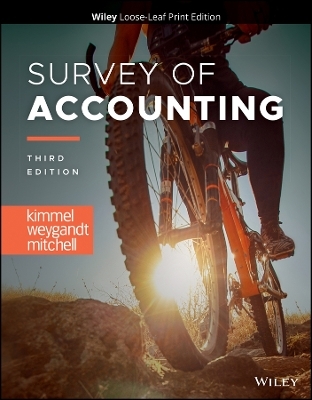
Survey of Accounting
John Wiley & Sons Inc (Verlag)
978-1-119-89568-8 (ISBN)
- Titel ist leider vergriffen;
keine Neuauflage - Artikel merken
1 Introduction to Financial Statements 1-1
1.1 Business Organization and Accounting Information Uses 1-2
1.2 The Three Types of Business Activity 1-8
1.3 The Four Financial Statements 1-11
2 A Further Look at the Balance Sheet 2-1
2.1 The Classified Balance Sheet 2-2
2.2 Analyzing the Balance Sheet Using Ratios 2-8
3 The Accounting Information System 3-1
3.1 Financial Reporting Concepts 3-2
3.2 Using the Accounting Equation to Analyze Transactions 3-8
4 Accrual Accounting Concepts 4-1
4.1 Accrual-Basis Accounting and Adjustments 4-2
4.2 Adjustments for Deferrals 4-8
4.3 Adjustments for Accruals 4-15
4.4 Preparing Financial Statements 4-21
5 Fraud, Internal Control, and Cash 5-1
5.1 Fraud and Internal Control 5-3
5.2 Cash Controls 5-12
5.3 Control Features of a Bank Account 5-17
5.4 Reporting Cash 5-26
6 Merchandising Operations and the Multiple-Step Income Statement 6-1
6.1 Merchandising Operations and Inventory Purchases 6-2
6.2 Recording Sales Under a Perpetual Inventory System 6-9
6.3 Multiple-Step Income Statement 6-13
6.4 Gross Profit Rate and Profit Margin 6-17
7 Reporting and Analyzing Inventory and Receivables 7-1
7.1 Classifying and Determining Inventory 7-3
7.2 Inventory Methods and Financial Effects 7-6
7.3 Reporting Receivables 7-15
7.4 Inventory Presentation and Analysis 7-23
8 Reporting and Analyzing Long-Lived Assets 8-1
8.1 Plant Asset Expenditures 8-3
8.2 Depreciation Methods 8-8
8.3 Plant Asset Disposals 8-16
8.4 Intangible Assets 8-18
8.5 Statement Presentation and Analysis 8-23
9 Reporting and Analyzing Liabilities and Stockholders’ Equity 9-1
9.1 Accounting for Current Liabilities 9-3
9.2 Accounting for Bond Transactions 9-9
9.3 Accounting for Common, Preferred, and Treasury Stock 9-15
9.4 Accounting for Cash Dividends 9-24
9.5 Presentation and Analysis of Stockholders’ Equity 9-28
10 Financial Analysis: The Big Picture 10-1
10.1 Sustainable Income and Quality of Earnings 10-3
10.2 Horizontal Analysis and Vertical Analysis 10-9
10.3 Ratio Analysis 10-15
11 Managerial Accounting 11-1
11.1 Managerial Accounting Basics 11-3
11.2 Managerial Cost Concepts 11-7
11.3 Manufacturing Costs in Financial Statements 11-12
11.4 Managerial Accounting Today 11-16
12 Job Order Costing 12-1
12.1 Cost Accounting Systems 12-3
12.2 Assigning Manufacturing Costs 12-8
12.3 Predetermined Overhead Rates 12-13
12.4 Jobs Completed and Sold 12-16
12.5 Applied Manufacturing Overhead 12-22
13 Cost-Volume-Profit 13-1
13.1 Cost Behavior Analysis 13-3
13.2 Mixed Costs Analysis 13-8
13.3 Cost-Volume-Profit Analysis 13-11
13.4 Break-Even Analysis 13-16
13.5 Target Net Income and Margin of Safety 13-20
14 Incremental Analysis 14-1
14.1 Decision-Making and Incremental Analysis 14-3
14.2 Special Orders 14-6
14.3 Make or Buy 14-8
14.4 Sell or Process Further 14-11
14.5 Repair, Retain, or Replace Equipment 14-14
14.6 Eliminate Unprofitable Segment or Product 14-16
15 Budgetary Planning 15-1
15.1 Effective Budgeting and the Master Budget 15-3
15.2 Sales, Production, and Direct Materials Budgets 15-8
15.3 Direct Labor, Manufacturing Overhead, and S&A Expense Budgets 15-14
15.4 Cash Budget and Budgeted Balance Sheet 15-18
15.5 Budgeting in Nonmanufacturing Companies 15-23
16 Budgetary Control and Responsibility Accounting 16-1
16.1 Budgetary Control and Static Budget Reports 16-3
16.2 Flexible Budget Reports 16-7
16.3 Responsibility Accounting and Responsibility Centers 16-14
16.4 Investment Centers 16-24
17 Standard Costs and Balanced Scorecard 17-1
17.1 Overview of Standard Costs 17-3
17.2 Direct Materials Variances 17-8
17.3 Direct Labor and Manufacturing Overhead Variances 17-13
17.4 Variance Reports and Balanced Scorecards 17-18
18 Planning for Capital Investments 18-1
18.1 Capital Budgeting and Cash Payback 18-3
18.2 Net Present Value Method 18-6
18.3 Capital Budgeting Challenges and Refinements 18-12
18.4 Internal Rate of Return 18-17
18.5 Annual Rate of Return 18-20
Appendix A Specimen Financial Statements: Apple Inc. A-1
Appendix B Specimen Financial Statements: Columbia Sportswear Company B-1
Appendix C Specimen Financial Statements: Under Armour, Inc. C-1
Appendix D Double-Entry Accounting System D-1
Appendix E Time Value of Money E-1
Company Index / Subject Index I-1
Available in the Wiley Online Course and Wiley Custom:
19 Statement of Cash Flows 19-1
19.1 Usefulness and Format of the Statement of Cash Flows 19-3
19.2 Preparing the Statement of Cash Flows— Indirect Method 19-6
19.3 Analyzing the Statement of Cash Flows 19-18
Appendix F Activity-Based Costing F-1
F.2 ABC and Manufacturers F-6
F.3 ABC Benefits and Limitations F-10
F.4 ABC and Service Industries F-16
Appendix G
G.1 Basic CVP Concepts G-1
G.2 Sales Mix and Break-Even Sales G-5
G.3 Sales Mix with Limited Resources G-9
G.4 Operating Leverage and Profitability G-10
Appendix H Pricing H-1
H.1 Target Costing H-2
H.2 Cost-Plus and Variable-Cost Pricing H-3
H.3 Time-and-Material Pricing H-7
H.4 Transfer Prices H-9
| Erscheinungsdatum | 08.12.2022 |
|---|---|
| Verlagsort | New York |
| Sprache | englisch |
| Maße | 218 x 277 mm |
| Gewicht | 1928 g |
| Themenwelt | Wirtschaft ► Betriebswirtschaft / Management ► Rechnungswesen / Bilanzen |
| ISBN-10 | 1-119-89568-5 / 1119895685 |
| ISBN-13 | 978-1-119-89568-8 / 9781119895688 |
| Zustand | Neuware |
| Informationen gemäß Produktsicherheitsverordnung (GPSR) | |
| Haben Sie eine Frage zum Produkt? |